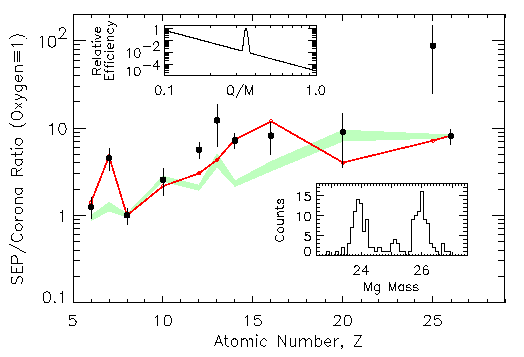
| ACE News Archives | ACE News #69 - Mar 28, 2003 |
ACE News Archives |

In 3He-rich solar energetic particle (SEP) events, abundance ratios of 3He/4He commonly exceed the value found in the solar wind (~5 x 10-4) by 3 orders of magnitude or more. In addition, abundance enhancements of heavy ions (relative to coronal values) tend to increase with increasing mass, resulting in excesses of Fe/O of ~10x and of "ultraheavy" (Z>30) elements by even larger factors. Attempts to explain this highly-selective fractionation have generally focused on plasma processes capable of heating and/or accelerating ions over quite restricted ranges of charge to mass (Q/M) values.
The ULEIS and SIS instruments on ACE have, for the first time, observed 3He-rich SEP events with composition patterns radically different from "average" impulsive SEPs (see also ACE News #62). In addition to large enhancements of specific elements relative to neighboring elements (e.g., N relative to C and O), isotopic composition measurements have revealed extreme isotopic fractionation in certain elements. The above Figure shows data from one of these highly-fractionated 3He-rich events (3 August 2002). Observed abundances (points) relative to coronal values are compared with average impulsive-event abundances measured by ISEE-3 (green shaded region) and with a simple fractionation model in which an isothermal sample (T=1.66 MK) of material of standard coronal composition (solid red line) is fractionated based on Q/M according to the function shown in the inset at the upper left. The model abundances, in which Q/M values slightly greater than 1/3 are strongly favored, are in much better accord with the observations than are the average impulsive abundances. In the model, the combination of relatively low temperature and resonant fractionation is enhancing 14N+5 (Q/M=0.357), 26Mg+9 (0.346), and 32S+11 (0.344) relative to 12C+4 and 24Mg+8 (both 0.333) and to 16O+6 and 24Mg+9 (both 0.375). Isotopic composition measurements from SIS (inset at lower right) confirm the presence of an extreme enhancement (~7x) of the 26Mg/24Mg ratio relative to the value of 0.14 in the source material before fractionation.
It is hoped that these observations will stimulate theoretical investigations to elucidate the physical mechanisms responsible for such extreme selective fractionation.
Contributed by Mark Wiedenbeck of JPL, Rick Leske of Caltech, and Glenn Mason of the University of Maryland.
Last modified 28 March 2003, by